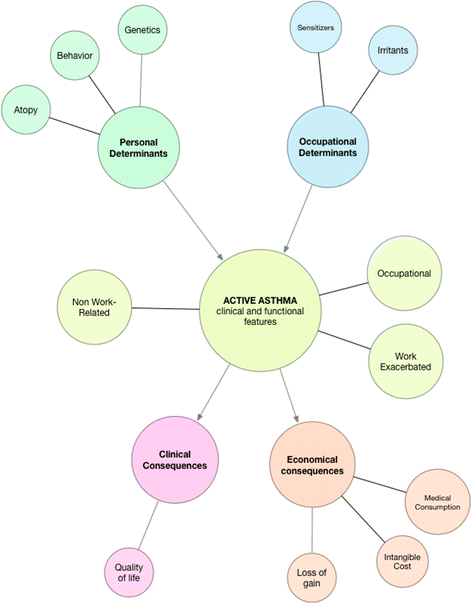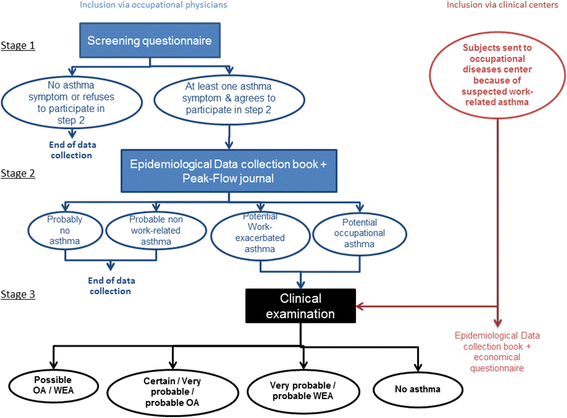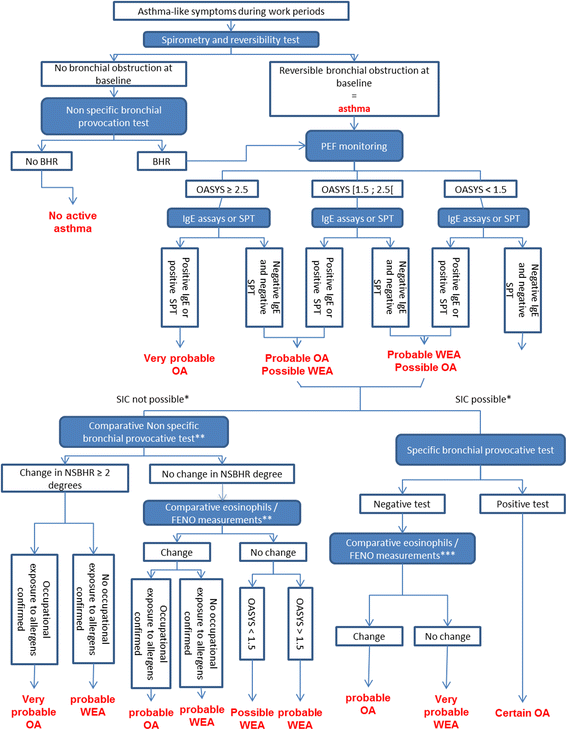Assessment of work-related asthma prevalence, control and severity: protocol of a field study
- PMID: 27852249
- PMCID: PMC5112681
- DOI: 10.1186/s12889-016-3824-0
Assessment of work-related asthma prevalence, control and severity: protocol of a field study
Abstract
Background: There are still uncertainties regarding the respective prevalence, diagnosis and management of occupational asthma (OA) and work-exacerbated asthma (WEA). There is as yet no standardized methodology to differentiate their diagnosis. A proper management of both OA and WEA requires tools for a good phenotyping in terms of control, severity and quality of life in order to propose case-specific therapeutical and preventive measures. Moreover, there is a lack of knowledge concerning their actual costs.
Methods: This project aims at comparing 3 groups of asthmatic subjects at work: subjects with OA, with WEA, and with non-work-related asthma (NWRA) in terms of control, severity and quality of life on the one hand, and estimating the prevalence of OA, WEA and NWRA in active workers and the economic costs of OA and WEA, on the other hand. Control will be assessed using the Asthma Control Test questionnaire and the daily Peak Exploratory Flow variability, severity from the treatment level, and quality of life using the Asthma Quality of Life Questionnaire. A first step will be to apply a standardized diagnosis procedure of WEA and OA. This study includes an epidemiological part in occupational health services by volunteering occupational physicians, and a clinical case-study based on potentially asthmatic subjects referred to ten participating University Hospital Occupational Diseases Departments (UHODD) because of a suspected WRA. The subjects' characterization with respect to OA and WEA is organized in three steps. In Step 1 (epidemiological part), occupational physicians screen for potentially actively asthmatics through a questionnaire given to workers seen in mandatory medical visit. In step 2 (both parts), the subjects with a suspicion of work-related respiratory symptoms answer a detailed questionnaire and perform a two-week OASYS protocol enabling us, using a specifically developed algorithm, to classify them into probably NWRA, suspected OA, suspected WEA. The two latter groups are referred to UHODD for a final harmonized diagnosis (step 3). Finally, direct and indirect disease-related costs during the year preceding the diagnosis will be explored among WRA cases, as well as these costs and the intangible costs, during the year following the diagnosis.
Discussion: This project is an attempt to obtain a global picture of occupational asthma in France thanks to a multidisciplinary approach.
Keywords: Asthma control; Asthma diagnosis; Asthma quality of life; Asthma severity; Medico-economical evaluation; Occupational asthma; Occupational epidemiology; Work-exacerbated asthma; Work-related asthma.
Figures



Similar articles
-
Work-exacerbated asthma and occupational asthma: do they really differ?J Allergy Clin Immunol. 2013 Mar;131(3):704-10. doi: 10.1016/j.jaci.2012.08.024. Epub 2012 Oct 8. J Allergy Clin Immunol. 2013. PMID: 23058644
-
Occupational risk factors associated with work-exacerbated asthma in Quebec.Occup Environ Med. 2012 Dec;69(12):901-7. doi: 10.1136/oemed-2012-100663. Epub 2012 Sep 21. Occup Environ Med. 2012. PMID: 23000826
-
Work-related asthma in a sample of subjects with established asthma.Respir Med. 2017 Sep;130:85-91. doi: 10.1016/j.rmed.2017.07.008. Epub 2017 Jul 14. Respir Med. 2017. PMID: 29206638
-
An official american thoracic society statement: work-exacerbated asthma.Am J Respir Crit Care Med. 2011 Aug 1;184(3):368-78. doi: 10.1164/rccm.812011ST. Am J Respir Crit Care Med. 2011. PMID: 21804122 Review.
-
Work-related asthma.J Bras Pneumol. 2021 Aug 11;47(4):e20200577. doi: 10.36416/1806-3756/e20200577. eCollection 2021. J Bras Pneumol. 2021. PMID: 34406224 Free PMC article. Review.
Cited by
-
Pulmonary Function Testing in Work-Related Asthma: An Overview from Spirometry to Specific Inhalation Challenge.Int J Environ Res Public Health. 2021 Feb 26;18(5):2325. doi: 10.3390/ijerph18052325. Int J Environ Res Public Health. 2021. PMID: 33652998 Free PMC article.
References
-
- Aasen TO, Kongerud J. [Work-related asthma--diagnostics and follow-up]. Tidsskrift for den Norske laegeforening : tidsskrift for praktisk medicin, ny raekke. 2014;134(20):1955–9. doi:10.4045/tidsskr.13.1225. - PubMed
MeSH terms
LinkOut - more resources
Full Text Sources
Other Literature Sources
Medical

